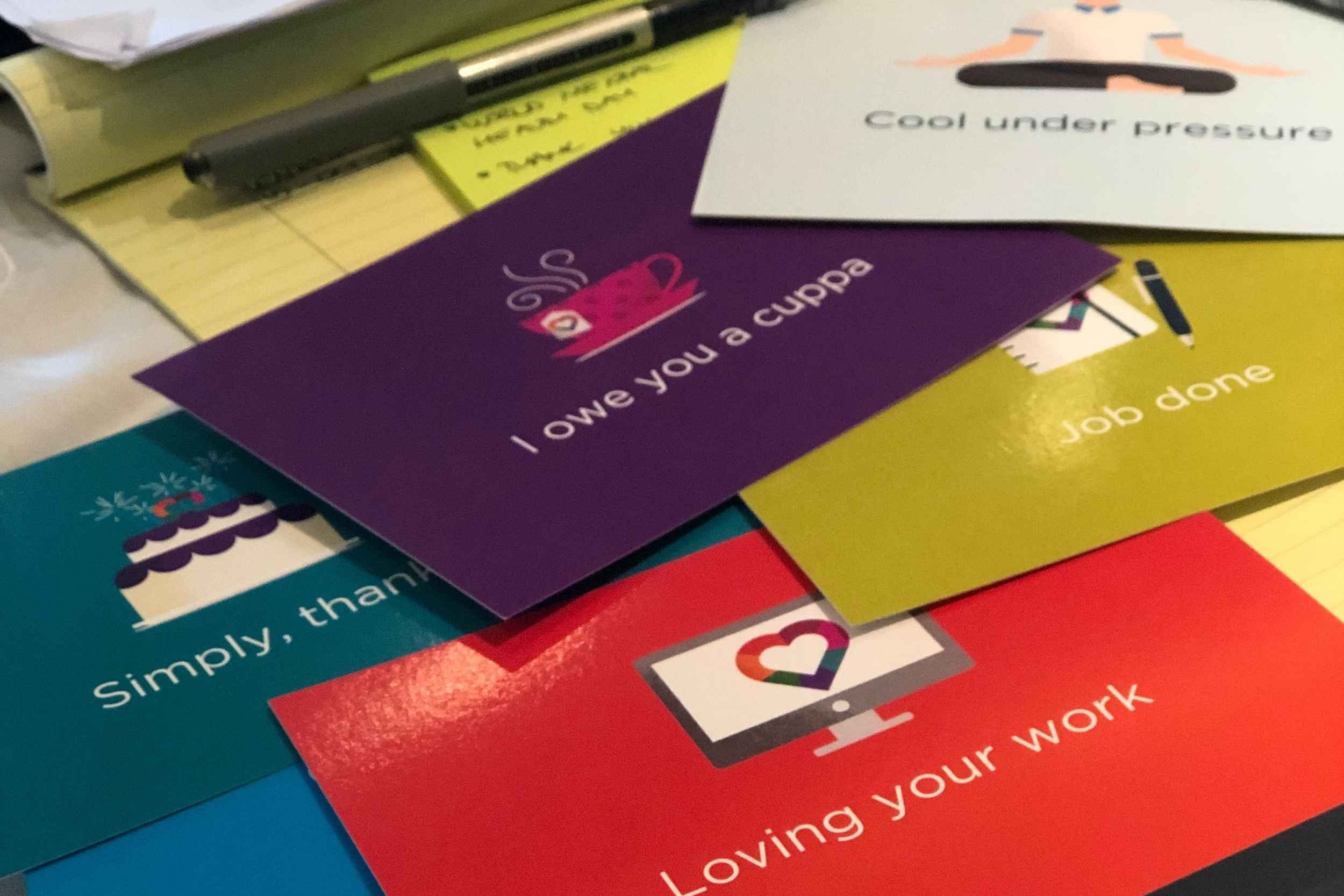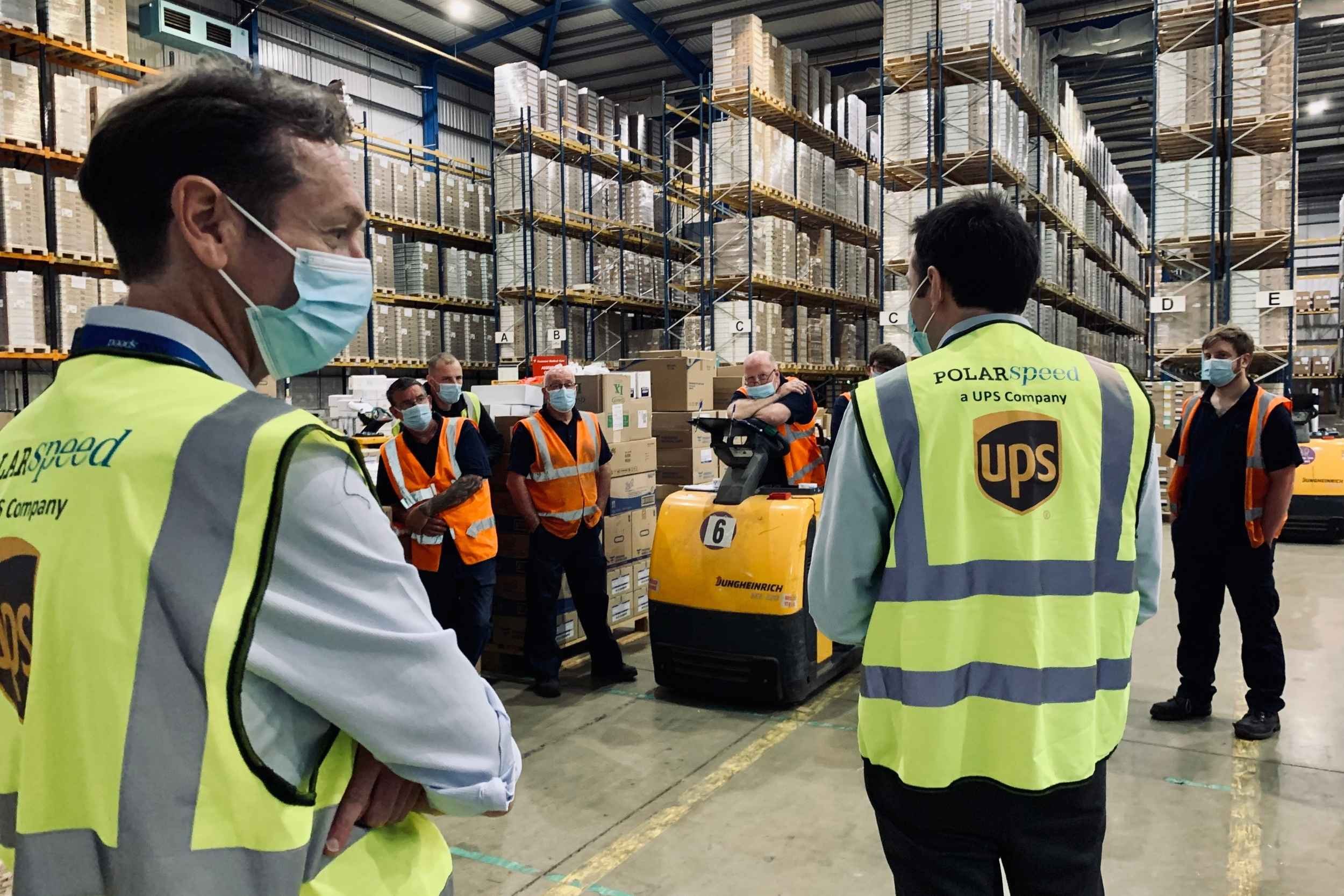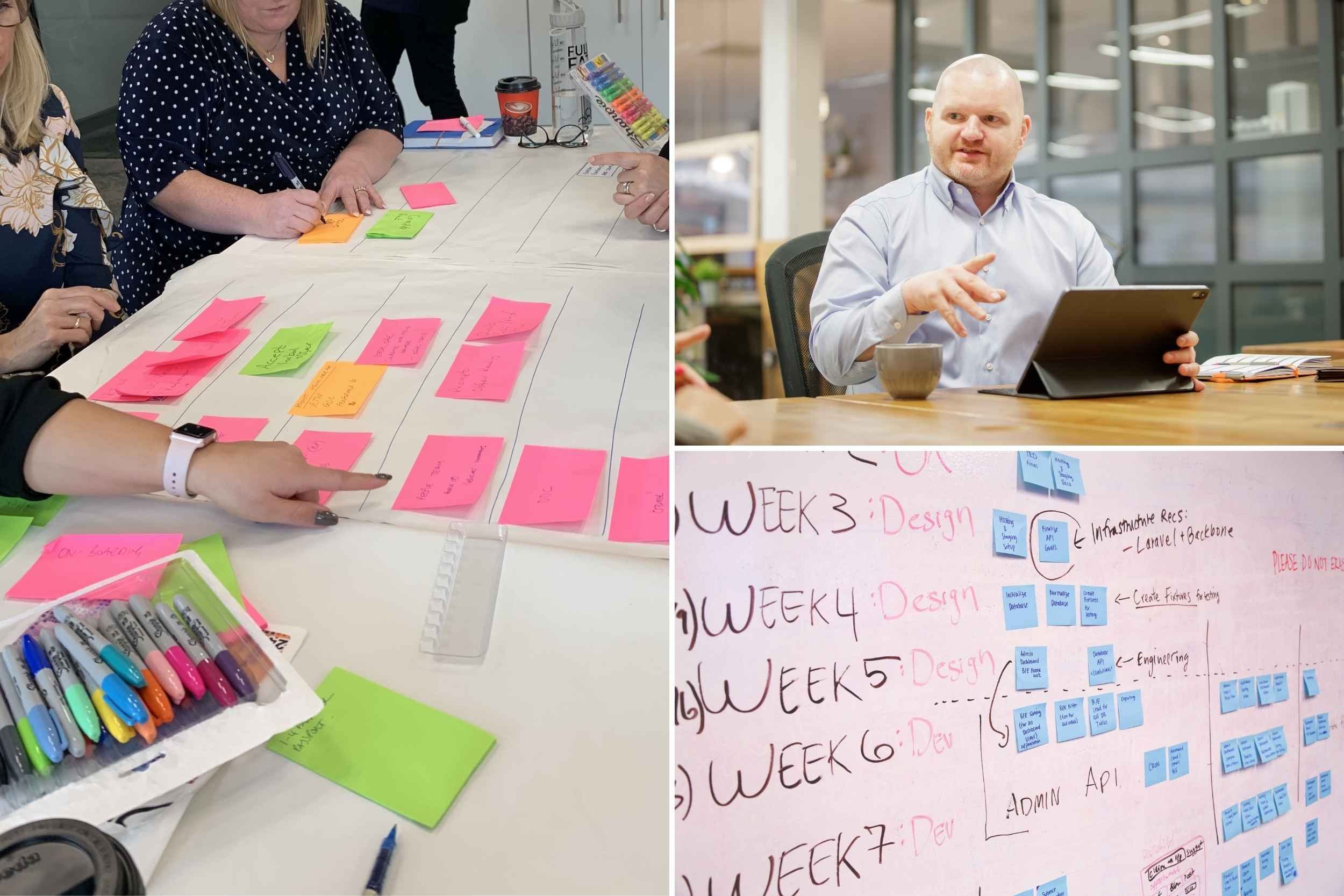Many businesses are now under extreme financial pressure, as the price of energy bills, goods and services continues to rocket. But that’s not all CEOs are worrying about, in addition most decent bosses will also be deeply concerned about how their people will survive the coming months.
CEOs are grappling with current cost of living crisis and how the aftershocks of the pandemic effect their operations. But you can’t separate the prosperity of a business from the prosperity of the workforce. There is now a growing, immediate need to make sure people have food, warmth and shelter. How shocking is it to read that several NHS Trusts have already set up food banks or launched food voucher schemes to support their staff?
As well as being an all-round total sh*tshow for running a business and a household, the UK cost of living crisis inevitably blurs the boundaries between home and work ‘problems’. The burden of everything being too expensive, weighing heavily on personal lives, work lives and mental health.
Leaders now recognise that the cost of living is affecting people at work
There’s no arguing that life feels uncertain, and the economic outlook is unclear. We don’t know how work will be affected by the cost of living crisis, and many business leaders are still trying to work out what to do for their customers and team members. If you understand what’s likely to happen in your business, it will help you design the right support for your team…
Our pandemic 'heroes' are going to suffer disproportionately vs. everyone else
“Individuals’ preference and satisfaction levels in relation to reward are dynamic, not fixed. External events, for example a recession, can affect individuals’ confidence, altering their satisfaction with current reward offers.” — CIPD 2015, Show me the money, the behavioural science of reward
Proactively talk to your team about the support available to them
Just yesterday, the Office for National Statistics (ONS) announced that the main measure of inflation, the Consumer Prices Index (CPI) was 11.1% in October 2022, up 10.1% in September 2022. CPI is at an eye-watering figure and it’s not something you can control, so what can you do?
In addition to the short and medium-term options we’ve discussed in this article, there are opportunities for leaders to help insulate employees against future financial hardship. Here’s some ‘slow-burn’ options that are likely to help with the family finances, and increase engagement, loyalty, productivity and performance.
We are passionate about finding ways to help bosses do the best they can to look after their people. Some of what we’ve outlined here is simple, but implementing activity that’s targeted to help those that need it most often gets businesses in a pickle. Primarily because they get bogged down about treating all employees the same. If you need help to work how to support those that need it in a way that’s fair and legal, then please drop us a line. We’d be happy to talk to you.


How will work life be impacted by the cost of living crisis?
Shift in balance of home / office working
Key workers will suffer disproportionately
Many working people with modest salaries will be in fuel poverty

What can CEOs do right now to support employees through the cost of living crisis?
If you’ve made more than you thought, share it!
Don’t pay for employee benefits that nobody uses
Satisfaction with pay, reward and benefits is constantly changing – you have to keep pace with the market!
Make sure everyone knows if help is already available
Plan for more people coming ‘in’ rather than working at home

What should CEOs do in the medium term to help employees survive inflation?
Pay your team fairly
Bring in independent advisors to help people
Creative thinking around the affordability of travelling to work
Help people charge their cars for free

How can CEOs insulate their staff against future financial hardships?
Performance-related pay scheme
Shadow equity schemes
Long term incentives plans (LTIP) for executives
Don't know where to start when it comes to supporting your team through the Cost of Living Crisis?
Category: Workplace Culture
HR myths busted: “Cost of living support – all staff, must be treated the same”
Doing the same for everyone means you are treating people equally. But your people are not all in the same position. Treating people fairly means that you do the right thing for that person, so you are meeting their individual needs. Giving everyone the same may feel fair, but it isn’t.

The cost of living crisis will not impact all your people equally. Higher earners will be better insulated to survive. How do you, as a CEO, implement support that helps the people that need it, without ostracising the people that don’t?

What is the difference between treating people equally and treating people fairly?
Doing the same for everyone means you are treating people equally. But your people are not all in the same position. Treating people fairly means that you do the right thing for that person, so you are meeting their individual needs. Giving everyone the same may feel fair, but it isn’t.
Equal treatment (i.e. the same) doesn't always produce an equitable outcome
One off payments may benefit higher paid staff more than lower paid colleagues
- There’s been a lot of publicity about one-off ‘cost of living payments’. Barclays, Co-operative Bank, Sky, Nationwide, Virgin Money, NatWest and HSBC are amongst many big brands that have decided to pursue this path.
- We urge you to think carefully before paying staff bonuses or making ‘cost of living’ payments.
- When you calculate a % of salary, or a cash lump sum remember that some formulas benefit higher-paid staff more than lower-paid staff. This defeats the object of financial support. Same goes for staff who earn commission and are on a relatively low-base pay, will you look at total earnings?

One off payments may increase your gender pay gap
If you’ve got a gender pay gap (and you probably have) and/or an ethnicity pay gap (which you also probably have and may not even measure) take care not to increase inequality through your actions.
Don’t assume low use of an existing benefit means it’s not valuable

You may inadvertently create a wider gender and ethnicity pay gap
If you’ve got a gender pay gap (and you probably have) and/or an ethnicity pay gap (which you also probably have and may not even measure) take care not to increase inequality through your actions
Not every benefit needs to have majority use to be valuable. Removing a low-use benefit might have a significant impact on some team members.
For example, a health cash plan, which gives cash back for dental, optical, and other routine health appointments, might be disproportionately beneficial to working families or those with long term health needs.
Be sure to check the impact of your decisions with a formal Equality Impact Assessment and by listening to your team before you act.
Don’t know where to start when it comes to supporting your team through the Cost of Living Crisis?
We are passionate about finding ways to help bosses do the best they can to look after their people.
Some of what we’ve outlined here is simple, but implementing activity that’s targeted to help those that need it most often gets businesses in a pickle. Primarily because they get bogged down about treating all employees the same.
If you need help to work how to support those that need it in a way that’s fair and legal, then please drop us a line. We’d be happy to talk to you.
How to Lead Hybrid Teams
Shake it all about! We all know traditional working practices have changed. People have been flipping between being in and out of the office for over 2 years now. Something which has undoubtedly shaken many companies.
Lots of office workers have now been instructed to return for at least some of the week. But the situation that greets them varies hugely between organisations, internal teams and even pay grades.

How does it feel if your CEO has said you have to be in the office everyday, but you’ve not seen them up close and personal for weeks?
Or how about if some teams in the business are in, but others are entirely home-based?
The aftermath of the pandemic has left a huge swathe of organisations with fragile, fractured or ‘not quite figured out yet’ working environments. Some organisations moved quickly to new working policies whereas others have muddled along without formalising new ways of working.
C-suite executives expect 87% of work to be done via some form of hybrid working
According to research by McKinsey, most organisations don’t yet have a detailed vision in place for hybrid working, with as few as 3 out of 10 organisations having both prepared for and communicated their vision for the post-pandemic world. Despite this, executives expect most work to be done via some form of hybrid work in future. Perhaps many of us are still in ‘reaction mode’ and the case for hybrid working is still unclear?

Why could a hybrid working model be good for my business?
If you’re considering it, it’s probably because you’re already doing it in some way. Hybrid working became a necessity in the pandemic.
Some organisations only did it because they had to, and for some companies, being at work in person will always be the best model for them.
Hybrid working is no longer a ‘nice to have’, it’s a ‘must have’ for most workers
Benefits of Working at Home
-
Focused periods of concentration on tasks that are best done uninterpreted.
-
A place to do virtual calls.
-
Good for those who need adjustments to their working environment, such as people with a disability.
-
More useable time in the day for those who have a lengthy commute.
-
A better work/life balance.
Benefits of Being in The Workplace*
Informal learning of technical knowledge… being in earshot of colleagues.
Learning good leadership skills by listening to and ‘soaking up’ the actions of positive role models.
More chance to naturally include less confident colleagues, in meetings that are in-person.
More opportunities for new starters to absorb company culture.
*Not of the ‘benefits’ of working in the workplace are effective if leaders and relevant colleagues are not there… AT THE SAME TIME!
Absorbing and contributing to company culture is virtually impossible at home

How do I lead a fully hybrid team?
Hybrid working is not new. Tech companies like Google have been doing it across teams successfully for many years.
The reason they and others adopted it in the first place was because it was better for productivity.
For hybrid working to work, leaders need to be clear and visible and employees need to understand how their work fits into big picture company objectives.
Agree the ground rules for hybrid working, including what leaders need to do
Five practical steps to successful hybrid working
There are some specific steps that every leader can take to make hybrid working work for you, your team and most importantly, your customers. One word of warning before you start…don’t be the CEO that says everyone has to work in a certain way, except you. That’s a sure-fire way to make sure hybrid working doesn’t work.
Step 1 – Make an Agreement (Formal or Informal)
If people have become used to the flexibility of 100% home working they need time to put a new routine in place.
Remember, people will be factoring in the cost of commuting, cost of living and childcare responsibilities.
You may be perfectly entitled to have them back in the office but do it with compassion.
Top Tip: an informal or formal agreement can help get people back into the office, particularly if different parts of your business need different levels of on-site and remote working.
Step 2 – Lead by Example
You may have always worked from home as a leader, but for hybrid working to be successful, days in the office have to be really meaningful.
You need to model this way of working to make sure that engagement with company culture and productivity stays high.
Not sure your company culture is strong enough? Here are 10 proactive things you can do as a leader to improve your culture.
Step 3 – Make Office Dates Matter
Understand which tasks work better at home and which benefit from face-to-face communication and plan around this.
There is no point in scheduling lots of virtual calls on a day when everyone’s in the office. It’s pointless. (Ever travelled to work, done a day of Teams or Zoom calls from the office, then travelled home when you could have been anywhere? Ergh.)
Also try to schedule company-wide office dates so that people are able to ‘drop in’ on useful colleagues.
Step 4 – Plan Unstructured Collaboration Time
Scheduling unstructured collaboration time will invigorate your team, encourage creative thinking and help people feel positive about coming into work.
A Deloitte survey of over 3,500 workers showed that people are up to 20% more satisfied with their workplace culture when they have access to collaboration tools that enable them to work in teams, and 34% happier with their workplace when collaboration and innovation are encouraged.
We also know that productivity, revenue, and profitability are all positively impacted by engagement at work – collaboration with colleagues is just one way to keep your team engaged.
Step 5 – More Office Time For New Starters & Their Managers
Your organisation is a complex web of different traits, habits, actions … ways of communicating.
All of these are compromised if newbies aren’t properly integrated into the organisation.
Plan extra time in the office for people joining your organisation and their managers.
Top Tip: set an expectation that managers are on-site with new colleagues for their induction, you can share the responsibility amongst a pool of managers so new starters kick-start their internal networking.
Ringfence your time at the office for collaboration and engaging with your team

Why can’t I get my team to come back to the office?
Lots of people like working from home but it’s not without challenges, subsequently a sensible hybrid model is a pretty logical way of working for most people.
So, if you’re really struggling to get people to come back, it’s likely that your office was not a welcoming, inclusive and flexible environment in the first place!
If you’re a leader that would like a conversation about how to create and manage a hybrid working model, get in touch. We’ll show you how to enhance every professional relationship across your entire business.
A welcoming, inclusive and flexible workspace is essential for hybrid working
Don’t know where to start?
I know that making changes to your workplace and culture can be daunting – most people don’t know where to start.
I love working with Exec Teams to improve performance and unleash the potential of their organisations. Who knows what you might achieve?
Give me a call if you want to explore the options for hybrid working in your team.
Image credits
Images sourced from Canva Pro and are photographers are not individually credited. If you see one of your photos above,please let us know so we can credit you here. Photo of Andrew Knight by Nick Morrish from Nick Morrish Photography
References
Digital collaboration. Delivering innovation, productivity and happiness. Deloitte (2013)
What executives are saying about the future of hybrid work. McKinsey & Company (2021)
Does your HR team make things easier or are they getting in the way?
We’ve talked a lot recently about how to spot when things aren’t going well. We’ve covered cultural blindspots, festering grievances and ineffective organisational structures.
In lots of cases these problems emerge because those in charge of managing HR are distracted by other stuff!
From holiday pay and recruitment challenges through to furlough – a busy HR team often gets bogged down with no time to see the big picture. It doesn’t have to be this way!
Changes to company infrastructure and HR systems could revolutionise the capacity of your HR team and make it easier for your organisation to get things done. After all, most (if not all) HR people want to do the best for you, your teams and your customers.
Our job as HR practitioners is to enable you to achieve your goals and objectives
Great. But what are HR doing, whilst I’m doing all the people stuff?

This might come as a bit of a shock, but virtually all day-to-day people management decisions should sit with line managers, not HR.
This means everything from 1:1s, performance coaching, recognising achievements, managing attendance, and so on…
Organisations that manage people through a centralised HR department are outdated and often not resourced effectively. Gone are the days of HR making decisions for managers or telling managers what to do.
In modern organisations, it’s HR that enables and managers that manage

It makes more sense for teams to be given the skills and flexibility to manage their people properly.
If you can achieve this, then your HR team will have the time and space to make your organisation function better. There are four things they can do to achieve this (Ulrich model):
Be a Strategic Partner
-
This is about the alignment of HR activities and initiatives with your business aims and strategy.
-
Strategic partners see beyond the internal function of HR to consider the customer and how best to organise the business to serve their needs.
-
It’s usually a job for HR Directors and HR Business Partners.
Be a Change Agent
-
An HR team can be instrumental in supporting change that helps the business to achieve its aims.
-
It’s not about restructuring for the sake of it.
-
The role of HR is to be an expert and trusted adviser, and driver of change activities.
-
They should also be able to understand the future skills and talent needed to make any organisational changes a success.
Be an Employee Champion
-
Being an employee champion is about doing the best for colleagues, leaders, and customers, it shouldn’t be confused with formal advocacy or trade union activity.
-
Good leadership, clear brand values and a solid organisational moral compass will nurture authentic employee champions.
-
These people are crucial and act as the conscience of the business, taking care of people at all levels equally, and prioritising ethical and fair business practices.
Be an Administrative Expert
-
We don’t mean the world’s fastest touch-typist!
-
In the past HR was about writing letters and documents for managers as they ‘couldn’t be trusted’ to do it themselves.
-
These days it’s about creating efficient administrative systems, providing user-friendly templates for managers to personalise and most of all, maintaining excellent HR technology that enables people.
-
In short, this is where HR can and should, get out of your way.
HR falls down when we focus on one role and not excellence in all areas

How are HR using technology to manage and enable people?
Knowing when to automate processes and when the human touch is still needed, is a key skill for HR leaders.
We all expect on-demand and instant service, from banking apps to self-service tills in stores, HR is no different.
Our colleagues expect to be able to easily make holiday bookings, record appraisal ratings and access their data at the touch of a button.
An HR team that’s nailed being an ‘administrative expert’ will be creating, maintaining, and evolving systems, tools, and technology to serve you better. Remember, a system with even a minimal level of automation can save hours of wasted time and admin that does not add value, freeing-up time for HR teams to add value in other ways.
HR technology can be used enhance engagement and save valuable time

What is the gold standard for a modern HR team?
Obviously, all organisations are different, but the key is to enable your HR Team to be an integral part of the business, not an afterthought.
HR Teams come in all different shapes and sizes, but the best and most effective HR functions a focused on their customers.
Award-winning HR Teams enable managers and teams to achieve their goals
We’ll give a gold star to any HR team that…
-
Puts the customer first – HR is a core support function, so an overhead that you need to get the best value for. HRBPs and HR Directors should be structuring the business to better achieve your customer goals. When you understand what the customer needs you can shape systems and processes accordingly.
-
Is a genuine catalyst for change – Top HR teams will ask tough questions about how you’re going to achieve your objectives. This can result in minor adaptations and actions, or major restructures and changes to how the business works. Either way, a top-notch HR team will be help you to manage change effectively and sustainably.
-
Empowers others to make change happen! – Your HR team should be the experts at enabling and empowering managers to deliver the business plan for your customers.
-
Makes the best use of talent and skill – Specialists specialise and generalists generalise. Wait…what? We’re talking about making the best use of talent, skill, and experience both within your team and elsewhere. Rely on your HRBP to get the best from your HR service and help you achieve your goals, and leave specialists to deliver project work and key goals across the organisation.
-
Is totally prepared to say ‘no’ – The best HR teams help leaders to avoid unfocused vanity projects and ad hoc ‘people initiatives’ (so unhelpful) that aren’t linked to a proper strategy or business goals. Empower your HR Team to say ‘no’ to things that will not help to achieve your vision.
How can I achieve HR gold?
Be bold and give more power to the people! If your HR team is micromanaging every person in your business from some ivory tower (or just a bog-standard red brick HQ) have a good think about what they could achieve if they weren’t rubber stamping holiday request forms or typing up appraisals.
There is so much that can be achieved by overhauling outdated systems. Even by introducing one single approval workflow in a business, we saved 1,000 hours of management time over a year.
Give me a call and I’ll explain how even minor changes like this can make a dramatic difference.
I need the help of a HR specialist to transform my HR function
You might not know how or where to start changing things to create extra capacity in your HR Team. You might need an experienced and knowledgeable HR specialist to help you get started and create an action plan.
I love working with HR Teams to release capacity and release their potential. Who knows what they might achieve?
Get in touch for a friendly chat about how I can help.
Image credits
Images sourced from Canva Pro and are photographers are not individually credited. If you see one of your photos above, please let us know so we can credit you here. Photo of Andrew Knight by Nick Morrish from Nick Morrish Photography
The Company Culture Blindspot
Before the article, a word or two about Ukraine 🇺🇦
When I drafted the outline for this article a few weeks ago, I couldn’t have imagined that Russia was about to invade Ukraine. At that time the rolling-news agenda was dominated by #partygate, the Sue Gray report, the Met Police and the ‘toxic culture’ at 10 Downing Street. What a difference two weeks makes.
Like many of you, I’ve watched the news in horror, bearing witness to this unfolding catastrophe through the reports of journalists and the messages from the brave people of Ukraine. And let’s be honest; from my position of relative comfort and privilege, ‘thoughts and prayers’ are utterly insufficient.
If you want to do something to help, you can donate to the Disasters Emergency Committee Ukraine Humanitarian Appeal. By donating you’ll help DEC charities provide food, water, shelter and healthcare to refugees and displaced families. Also, the DEC Afghanistan Crisis Appeal remains open to respond to what the Head of the World Food Programme previously described as “the worst humanitarian crisis on earth”.
I’ve decided to publish this article as planned, because an organisation’s culture and leadership are key to the resilience, productivity and success of its team. This is especially important at times of uncertainty and crisis, whether the cause is close to home and (potentially) controllable, or further afield and out of our control. So, what does your company culture say about you, how you manage uncertainty, and how you support your team?
Can you see what your workplace culture says about your business?
Having a strong workplace culture can be a lifeline in times of pressure or stress. Internal strains aside, whatever’s happening in the world will have an impact on your workforce. Whether the pressures and stresses your team are feeling are as a result of Brexit, COVID-19 or a raging war, a working environment that feels psychologically safe is really important.

Prior to the Russian invasion of Ukraine, the ‘toxic culture’ of both Downing Street and the Met Police dominated the news for what felt like forever. Understanding that culture change is key in transforming an underperforming business is not an alien concept to many leaders.
Most leaders understand the necessity of good workplace culture. The trouble is that even though we know what it means, it can still be hard to recognise what’s happening in our own organisations.
Most leaders don’t know how to objectively measure and assess company culture
In this article, we discuss a few positive and negative indicators that you might recognise from your own business. Lots of positives means Sue Gray is never going to knock on your door…but more than a handful of negatives is a definite red flag.
Think of your organisation as a complex web of different traits, habits, actions … ways of communicating. Johnson and Scholes mapped this out in their Cultural Web tool into six high-level categories, which we’ve unpicked here.
Control Systems
Organisation Structures
Power Structures
Rituals & Routines
Symbols
Stories

What are the positive signs that we have a healthy work culture?
Let me be clear here, the perfect culture does not exist (sorry not sorry to the perfectionists out there). Whenever I work with clients on cultural change, I’m always on the lookout for positive signs of a healthy culture.
Some indicators will be subtle, and some are glaringly obvious. You might have a handle on the formal culture across the business but find gauging the informal culture is much harder.
Culture can be subjective but you can objectively assess the formal and informal elements in your workplace
Formal indications of a healthy work culture
• Control Systems – colleagues accept responsibility to support and develop others. Balanced decision-making is valued. Information is shared transparently, with no mind games!
• Organisational Structures – teams work collaboratively. Purpose and strategy are clear to all. Learning from failure is encouraged and there is space to make mistakes without unfair reprisals.
• Power Structures – clearly delegated authority. Leaders are open to (and seek) challenge. Teams tend to be self-managing. There is a high-trust environment.
Informal indications of a healthy work culture
• Rituals & Routines – culture of learning and nurturing talent. Customers at the heart of all decisions, inclusivity beyond legal requirements.
• Symbols – success and failure leading to innovation is celebrated. An informal hierarchy. Strong, organised internal communication tools. Leaders shape culture through their actions.
• Stories – no rumours or gossip (ok, minimal rumours or gossip), all information is shared, listening is valued, clear guidance on how conflict is managed.
If you only come across positive indications…you’re not looking hard enough!

What are the signs that our culture isn’t doing us any favours?
Reminder: the goal is to check the health of your company culture and it would be weird if you didn’t come across some negative indications, so please try to be open to them.
If you notice one-offs from the list below that might not mean you’ve got a problem; after all, none of us are perfect, right?
But lots of negatives are a red flag and indicate you’d benefit from digging a little deeper.
So take a deep breath… and dive in…
None of us are perfect, but if you notice lots of red flags, it’s time to dig a little deeper
Formal indications of an unhealthy work culture
• Control Systems – areas of the business where ‘management’ is feared. Sales or performance incentives drive inappropriate behaviour. Processes are side-stepped with workarounds.
• Organisational Structures – business units operate in silos or with minimal collaboration. Diaries are overloaded with meetings. Promotions are decided based on who you know.
• Power Structures – leaders make unilateral decisions without adequate consultation. Information is managed on a ‘need to know’ basis. Challenge is absent, discouraged or simply ignored.
Informal indications of an unhealthy work culture
• Rituals & Routines – communication is a one-way street. Leaders broadcast messages and employees are told to leave their personal life at the door.
• Symbols – there are unwritten rules about teams, people, or places to avoid in the business. Some teams are higher in the pecking order than others and burnout is a badge of honour.
• Stories – whispers of toxic behaviour tolerated from high earners or top performers, managers ‘throwing their weight around,’ gossip about leadership conflicts.
If you only come across negative indications…take a step back and check your own blind spots (and biases)!
If you recognise some of these points, consider whether your team feel psychologically safe enough to raise them with you themselves? Having a working environment that allows people to feel comfortable speaking truth to power is a vital part of a healthy company culture.
It is challenging, but possible, to assess your culture from the inside. There are lots of tools available to assess culture and there are simple things you could try and implement straight away to make your place a better place.
Here’s a link to my list of 10 proactive and pragmatic things leaders can do immediately to influence company culture, split into organisation-wide, team and individual actions.
Invest in your culture
If you’ve read this far you know it matters! Assess how you can do better – happy, healthy, profitable businesses put aside time and effort into nurturing a positive culture. Assessing your culture needs a coordinated approach and, particularly in a large business with lots of divisions, it may feel like a daunting task.

If it’s too much, an external consultant might be a worthwhile investment. It’s more cost effective to pay an HR expert to do it right first time, than getting an internal team to struggle with it over a longer period.
A fresh pair of eyes will often see more when it comes to diagnosing cultural problems and will be able to help you create a plan of work to implement and manage change.
“Andrew at The Spark Company is a great partner for a business to work with. He combines a practical, no-nonsense approach with good technical knowledge and quickly builds a rapport with existing teams to hit the ground running”.
⭐️⭐️⭐️⭐️⭐️ Google Review
Choosing the right HR Consultant (and get a return on your investment)
Your organisation’s culture and values are essential to your performance and success, but how do you measure them?
If you aren’t sure where to start when it comes to a culture review or diagnostic; or if you’re ready to make a positive change to your organisation’s culture, values and performance, I’d love to hear from you.
Get in touch for a friendly chat about how I can help.
10 proactive things leaders can do now to influence company culture
It is challenging, but possible, to change your culture. There are lots of tools available to assess culture and there are simple things you could try and implement straight away to make your place a better place.

I’ve pulled together 10 straightforward and pragmatic ideas for leaders who want to improve workplace culture. It’s time to get stuck-in with some practical and actionable things that you can do in any organisation.
I’ve split these actions into organisation-wide, team and individual actions. It’s best practice to hit all three levels to give your culture change a chance to stick.
But before you start, imagine your organisation as a complex web of different traits, habits, actions … ways of communicating. If you really want to get under the skin of what’s going on, check out our article on company culture blindspots and make sure you’re not missing something crucial to your team’s success.
Your organisation is a complex network of different traits, habits, actions and ways of communicating
Things I can do as an individual to improve company culture
• Articulate your vision – Clearly explain what your vision is, get the senior managers onboard and create a plan to communicate across the business.
• Live by your values – Make sure your decisions align with the values of the organisation, both in good times and tough times. Personally demonstrate the business values every day.
• Talk to your customers – Find out what your customers really think of you. Using an external consultant here can encourage a customer to speak more freely and give honest feedback.
Things I can do as a manager to improve company culture
• Analyse all available data – Gather statistics that reflect how your culture is impacting customers and staff. Consider: customer complaints, Glassdoor reviews, Trustpilot reviews, attrition rates/absences and staff complaints.
• Listen to your team – Spend time with people. Visit the shop floor. Be seen. Be approachable. Get to know your staff and ask them what their experience of the business is.
• Recognise how COVID-19 changed how teams work – How has hybrid working during COVID-19 impacted team culture? Avoid ‘forced fun’. Consider scheduling people to be on-site at the same time, so they can work together naturally. Online collaboration time can be as helpful as blocking-out time for deep and meaningful work.
• Monitor workload & set boundaries – Make sure that everyone has an equal chance of success, time to meet customer expectations, and sufficient down-time. Consider a ‘no video meeting day’ each week, to allow space to focus.
Things I can do across my organisation to improve company culture
• Survey your team – When did you last benchmark how people are feeling? You could survey all your staff to see how they are feeling about the organisation post-pandemic. (Maybe a statement of the obvious, but only do this if you have bandwidth to analyse the results, listen to what you’re being told and crucially, do something about it.)
• Review your organisation design – Has any unfairness crept in due to remote working during the pandemic? Have you buried problems by some people not being physically present? Is everyone clear on who their manager is and who they go to for help?
• Improve internal communications – Check your communication channels work and reflect your company values. Are you sending a weekly newsletter into a black hole? Are people engaged? Is it 100% broadcast or is there interaction? If you are getting interaction, does everyone have a chance to join in?
Quick fixes won’t create a lasting and positive culture
Invest in your culture
Why bother investing in company culture? Well, it’s no coincidence that happy, healthy, profitable businesses put aside time and effort into nurturing a positive culture. Let’s be clear, this is a conscious choice that leaders make to invest in a positive, inclusive and productive workplace culture. It doesn’t have to be difficult but culture change does have to be planned and coordinated.

Taking action, particularly in a large business with lots of complexity, may feel like a mammoth task. This is particularly true if you’re not sure where to start.
Company culture is a bit like health & safety, compliance, safeguarding, etc.; it’s everyone’s job to develop and grow a positive workplace culture, but it starts with you. Leaders set the tone.
If the idea of cultural change is too much, an external consultant might be a worthwhile investment. It’s more cost effective to bring in a HR Consultant to do it right first time, than asking your team to try and pull together a plan for culture ‘off the side of their desks’ (and usually over a longer period).
Positive culture doesn’t just happen. Bring in an expert to get things moving and upskill your team
Depending on your workload and available resources, I’d always suggest allocating someone specific to lead on cultural change, whether this means bringing in an expert to work alongside and upskill your team, or giving someone a secondment or project opportunity. That way you’re getting focus and energy in the right place, and developing your own in-house capability at the same time.
However you do it, it’s all about enabling you to take control of your own cultural destiny and not being ‘done to’ either through inertia or reacting badly to events because your culture isn’t resilient or flexible.
I want to make positive cultural changes, but I need help getting started…
It can be daunting to get started, so you might need an experienced and knowledgeable HR consultant to assess your culture and create an action plan.
As a specialist in organisational change I love to get stuck-in and support clients to make positive changes in the workplace.
Get in touch for a friendly chat about how I can help.
Help! I need to resolve a complex grievance without bias or prejudice. It’s time to bring in an expert.
An independent grievance investigation can help you stop an employment tribunal claim in its tracks. Here’s how:
Most of us know that in the long run, not addressing a problem that’s perceived to be our fault is a bad idea. We may think we’ve done nothing wrong, and may disagree with the accusation but not talking about it doesn’t make it go away. It’s the same in the workplace.
When a problem emerges, failure to act can lead to an employment tribunal (very expensive) decreased staff morale (increased attrition rates) and damaged reputation (decrease in profits). Somewhere between a small problem and full-blown employment tribunal is a formal grievance, that needs to be investigated.
Can’t I just sort it out myself?
Initially you may have tried to solve a grievance yourself. Perhaps it started as an informal complaint or discussion which then escalated to something more significant.

Once a formal grievance has been made then it may become impossible to deal with internally. Sorting it out yourself only works if you can find somebody to conduct a confidential investigation that is totally impartial.
In this blog post what you can expect and why it’s worth avoiding the eye-watering costs of an employment tribunal.
You cannot be impartial or fair, if you investigate a grievance that you’re involved in
However far removed the investigator is from the complainant if they are part of the same business, or closely connected to the business in some way, it’s difficult to see how they can be totally unbiased. Impartiality is one of the most important considerations when conducting a grievance process.
What if things have become really awkward?
Let’s be frank; your main objective should be to resolve the situation amicably and acknowledging if you’re at fault. That means dealing with any misunderstandings that might have occurred and definitely saying sorry and putting things right, if you’ve done something wrong.

Even if you’re 100% sure that you’ve done nothing wrong, it’s good to keep an open mind and focus on a positive resolution.
It might be difficult to continue working with someone who has raised a grievance, but don’t let that stop you from doing business and serving your customers.
If you’ve done something wrong, say sorry and put it right as soon as you can
It takes resilience and integrity, but you’ll get through this. Raising a complaint and submitting a grievance is a big deal, so despite any misgivings you may have, try to bear in mind that your colleague/employee is probably feeling awkward too.
How should I choose an independent investigator?
If you’re tempted to conduct an investigation using internal resources, it’s worth bearing in mind that biases or individual concerns may prevent enquiries from being carried out fairly, particularly in those tricky cases when senior team members are accused of wrongdoing.

There are a handful of common-sense checks that you can carry out before you choose an external and independent investigator.
You’ll need to be able to trust them implicitly because you’re not going to learn what’s been said until the end. You should also take steps to make sure they’re not connected to your business or complainant.
You can ask for references or speak to previous clients, without breaching confidentiality (of course)
Top tips for choosing and commissioning an independent investigator:
-
Do your research, thoroughly – Check their qualifications credentials and experience. Ask if they’ve worked in your industry or sector before, and whether they’ve had experience investigating a complex grievance in the past. I often find that out-of-sector experience can be an advantage and give me an edge when I’m interviewing witnesses and weighing evidence; it gives me a broader range of comparison.
-
Share the full story to date – Give the investigator a summary of the case, including anything that may have gone wrong in the lead-up to the grievance. You’ll be dealing with a complex case by this point, so you may not be able to share everything until you’ve selected an investigator. When I’m being considered for a grievance investigation, I’m happy to sign an NDA or confidentiality agreement if needed.
-
Give clear terms of reference – Once you’ve chosen your investigator, you need to give them a proper brief. The most practical way to do this (and comply with the law) is to issue terms of reference. When I’m working with clients, the terms of reference are invaluable. The terms of reference tell me what I’m looking into and stop me from straying into unrelated areas.
-
Keep your nose out – Once the investigation gets going, the best thing you can do is keep your nose out of it! Don’t ask for updates about what’s said at each interview, you have to let the investigation run its course. When I’m investigating a case, I always keep the commissioning manager informed of my progress, without discussing the detail. It’s important to keep managers informed, so that the grievance investigation doesn’t interfere with the day-job.
-
Trust the process – Make sure you understand the process and the timescales at the outset. You need to be comfortable with when, where and how the investigation will take place, so that the process is fair and proportionate, but also so that it happens at a reasonable pace. When I’m investigating a grievance, I have a clear plan which complies with ACAS guidance. It’s designed to make the investigation as quick and easy as possible for everyone, and to avoid negative effects on the complaint, manager and the business.
-
Allow access to information and people – Don’t be surprised if your initial witness list and evidence changes during the investigation. If other people are implicated as witnesses or even potential victims, be prepared to allow the investigator to talk to them without asking why. You might find that it’s hard not to be curious and concerned. I always flag if there’s a safeguarding, regulatory or legal concern that might affect the business, so you’ll know if you need to act immediately to prevent harm or reduce risk.
-
Be open minded – By the time we get to an investigation, a lot of bad things have been said and there may be bad feeling. Don’t presume one party is guilty and another is innocent until you have the report. You may be treading on eggshells, so I always advise clients not to do anything that might sway proceedings, but also, not to be afraid of managing their business ‘as normal’.
Doing a proper investigation and sticking the process helps to protect you
Remember, investigating a grievance properly and sticking the process, helps to protect you should for any reason the grievance end up in legal proceedings. You will have to demonstrate that you followed all the rules, including your own internal policy, and that you carried out a fair and impartial investigation.
“I can't recommend Andrew and The Spark Company highly enough. He helped me to resolve a tricky and confidential employment issue; gave me pragmatic advice and supported me all the way.”
⭐️⭐️⭐️⭐️⭐️ Google Review

What will a good impartial investigator do?
There are some situations in the workplace that are best approached confidentially and objectively. Grievances are top of this list.
You might feel nervous about the prospect of a stranger coming into your team and asking lots of questions. As with any relationship, don’t be afraid to set ground rules and agree clear expectations. This will reassure you and give you confidence.
An external investigator should reassure you, remain objective, and carry-out a thorough investigation
8 ground rules for an independent investigator:
1. Conduct an unbiased, expert investigation – Hiring the help of an independent specialist gives you reassurance that the investigation is being carried out without bias or prejudice. This might seem like something straight from the Ministry of the Obvious, but independence brings scrutiny and credibility.
2. Gather all the facts at the outset – Most investigations begin with a scoping call to outline the nature of the investigation and other details about the assignment, such as duration. This is followed by confirming the terms of reference and reviewing any documents and evidence that may be required.
3. Stick to the brief – If it looks like the scope of the investigation needs to be widened, this shouldn’t be done without consulting the commissioning manager.
4. Interview the complainant and review evidence – The next step involves meeting with the complainant and relevant witnesses, taking notes of meetings and reviewing any additional documents or evidence. This can be done face-to-face, virtually, or both. As new evidence comes to light, it may be necessary to re-interview some individuals. Decent investigators consider both the context and the facts being presented. It’s important to understand what was going on at the time that an action was taken, or something was said.
5. Share progress about the process not the person – They should keep everything confidential. They may undercover lots of thorny issues which needs to be properly untangled. Staying connected with the commissioning manager is important, but don’t expect the investigator to breach confidentiality or give you hints about what is said whilst the investigation is ongoing.
6. Understand what’s illegal vs what’s bad practice – The only time that an investigator should share something mid-way through the process, is if they find something serious or illegal that means they have a duty to act. For example, an ongoing safeguarding issue. It’s important that the investigator understands when they have a duty to act.
7. Protect employees that may be vulnerable – In some cases, the complainant may be frightened. The consultant should be experienced enough to instigate a process that is appropriate. For example, a meeting with a complainant about a manager who they’ve accused of bullying them, might need to take place off-site. A good investigator anticipates these issues and should support you to look after the well-being of those involved… grievances are incredibly stressful.
8. Give a comprehensive report at the end – When the investigation has concluded, you’ll receive an investigation report that includes a list of all evidence considered, witnesses interviewed, findings, recommendations and suggested next steps. If follow-up meetings are required, these can also be arranged.
A thorough investigation is also an opportunity to identify what’s going well and how you can improve
Most employers appreciate it when an investigator identifies lessons learned and ways for the organisation to improve. It’s easy to be critical with hindsight; the best investigators will prepare a considered report, offering constructive criticism and highlighting where things went right, as well as missed opportunities to get things ‘back on track’.
A de-brief including lessons learned is something that I offer as a standard; after all it makes good business sense to use your investment in an external investigation as a catalyst for improvements in the workplace.

Why is it worth getting right?
Failure to investigate competently could lead to further complaints or even an employment tribunal claim, it makes better sense to hire an external confidential investigator – someone who can carry out the process in a balanced, objective, and efficient manner.
When you take a look at the number, the potential costs to a business of defending a tribunal claim are eye-watering.
Compensation awarded in employment tribunals can be huge. Just look at these pre-pandemic numbers:
Average compensation of £10,812 and a maximum of £118,842 for Unfair Dismissal
Sex Discrimination cases paid out £17,420 on average with a maximum of £73,619 in one case
Pay attention to age-related bias; £38,794 average and £243,636 maximum for Age Discrimination
The maximum pay-out in Disability Discrimination case in 2019/20 was a whopping £265,719
But wait, these figures don’t include legal fees, lost productivity, management time, or the cost of time away from your customers
Source: Ministry of Justice 2019/20 Tribunal Data
Many business leaders worry about the possibility of an employment tribunal…and with good reason. But when it comes down to it, as a leader you are expected to do what’s right, fair and within the law, every day. This means balancing the needs of your business, your team, your customers and external pressures on a daily basis. Not everyone will like what you do and it takes courage to make tough calls.
An open and positive workplace culture ultimately pays for itself; creating psychological safety and enabling your team to raise concerns quickly, informally, and without fear of repercussions. The result? Issues don’t fester and the risk of employment tribunal claims is reduced.
Remember, there are alternatives to formal grievances, including informal resolution and mediation
If a colleague submits a formal grievance, I always encourage managers to seek an informal resolution if at all possible. It’s better for the health and wellbeing of everyone involved, it helps you get back on track more quickly, and let’s be frank…it’s a better use of your time and resources. (In fact, I’ve worked with several organisations where a mutually agreed resolution has transformed a disgruntled colleague into an advocate.)
But when those tricky cases crop-up and you need to formally investigate a grievance, it pays to make sure that your process is fair, objective and thorough. Given the legal costs, potential compensation, and risk of reputational damage, it’s well worth the investment in a top-notch independent investigator.
“Andrew’s support and advice has undoubtedly saved us tens of thousands of pounds in legal fees, let alone the amount of time and energy we would have wasted on a legal battle. Bringing him in was definitely the right decision”
Source: Confidential HR Investigation client (2020)
Choosing the right HR consultant for confidential HR investigation
If you’re looking for an experienced and knowledgeable HR Consultant to conduct a confidential investigation or have any other concerns relating to the people and culture of your organisation, I’m here to help.
As a police-trained investigator with many years’ experience carrying out investigations on behalf of clients, I’m well-equipped to support you.
Get in touch for a friendly chat about how I can help.
Mergers and Acquisitions: How to Spot and Avoid Culture Clashes
There are rules for all the legal bits of a merger or acquisition process, yet there is no bible or handy instruction manual for the successful transfer or integration of company culture.

What is workplace culture?
There is no magic formula, but regular and meaningful is a good rule of thumb.
Workplace culture is your way of doing things, your approach and style of business. It’s the difference between ‘my door’s always open’ and ‘make an appointment with my PA’. It’s often tricky to explain but culture manifests itself through leadership style, how you treat your customers and colleagues, and the diversity of your workforce.
Culture can be seen in your people, personality, structure, purpose and values.
How can culture impact M&A?
An unforeseen culture clash creates an uncomfortable, disengaged work force.
If people don’t understand the values and objectives of the newly merged business they will quickly retreat into the familiarity of the old. This can slow down the integration of departments and operational systems. It also compromises customer service and sales if frontline colleagues don’t understand what kind of messages they should be communicating.

Every successful merger and acquisition has a plan to retain key talent and avoid an exodus
- Everyone’s talking about the great resignation at the moment, so it’s more important then ever before to have a plan for engagement, talent and culture. Especially if your acquiring a business or merging two organisations together.

How can I assess the culture of my acquisition?
It might be tricky to really get under the bonnet of your acquisition in advance of the legal transfer date. Certain information around TUPE, finances, compliance and commercial integration, are accessible. But when it comes to engagement and culture, you’re not going to be able to hover around the water cooler or join a team meeting to gather intel!
If you’re using an independent HR consultant to help you navigate the legal aspects of your merger or acquisition this can also be a great way to assess potential pain points and plan for the challenges ahead. An independent person may gain more access to the company being acquired and can help you learn more about the people you’re bringing in.
What clients say about our approach to M&A
“He did all the detail but he was also great at creating relationships. So whilst we were getting all the paperwork and legal stuff in place, he worked really closely with the individuals that were going to come into the business to build trust with them.”
Heyley Selway
Chief Executive, CCHA
“Studies from the Queens School of Business and the Gallup Organization showed that organizations with low employee engagement scores experienced 18% lower productivity, 16% lower profitability, 37% lower job growth, and 65% lower share price over time.”
Emma Seppälä & Kim Cameron
Harvard Business Review
Why does culture matter?
Clearly defined culture is a sign of a positive, engaged workforce, which means exceptional customer service, confident sales and marketing, increased productivity, reduced staff turnover and a better share price. Why? Because when everyone is working towards a shared vision your people are an amazing asset. When they don’t feel part of the bigger picture they switch off, and can do some serious damage.
Try to understand what the cultural differences are between the old and new company. Nip any opportunity for a ‘them and us’ dialogue to take hold with a clear communication plan that’s put into action pronto!

An engaged workforce is more profitable – can you afford not to think about culture?

Do leaders know how to promote positive culture?
If people are used to being managed in a certain way it can be deeply unsettling when a new regime comes along. One of the best ways to establish your organisation’s culture and ethos early on, is for management to get out on the shop floor and talk to people.
As a minimum, you should plan on hosting a Welcome Meeting where you can meet your new colleagues and tell them a bit about you and the new company. You can do more. Whether it’s a staff conference, video message, virtual event or just chatting informally to teams or individuals, nothing reassures people more than a boss that takes the time to listen.
As well giving people practical, operational information about how the business will look in the future it’s a great opportunity to gain insight into how people are feeling about the change.
A Welcome Meeting is a ‘must do’ when it comes to mergers and acquisitions
- Working out a change management plan in advance can give leaders structure and focus as they communicate their vision to employees old and new.
- This doesn’t come instinctively to everyone. You might be a sector-leading professional, with a multi-million pound business but actually have no idea how to inspire your workforce. Or you might just be shy! Use leadership coaching to help you articulate why the business matters and what your aspirations for the future are.
- It will help your team understand the right way of doing things and in times of pressure and stress they will feel confident about what you and the organisation stand for and which behaviours are unacceptable.


How can I take people with me?
As you plan for the future, consider the composition of your workforce.
If your organisation is office-based and you’re acquiring a business that works out in the field, how will you make those people feel welcome and avoid a two-tier workforce? Your ways of working and communicating historically may not suit your new colleagues. Sending an internal newsletter once a week via email is no good if half the business don’t sit at a desk (or have a smartphone).
As you move forward, find communication channels that work, so you can keep people informed, feeling part of the same team and contributing to your business goals.
Communicate in new ways to reach colleagues at all levels during and following an acquisition
- Ultimately it’s people that make the organisation tick, so make sure your people soak up the right information, so they’re able to perform in the way you want them to.
Don’t know where to start when it comes to supporting your team through the Cost of Living Crisis?
We are passionate about finding ways to help bosses do the best they can to look after their people.
Some of what we’ve outlined here is simple, but implementing activity that’s targeted to help those that need it most often gets businesses in a pickle. Primarily because they get bogged down about treating all employees the same.
If you need help to work how to support those that need it in a way that’s fair and legal, then please drop us a line. We’d be happy to talk to you.
How to put people at the heart of company decision making
Introducing a HR strategy that automates simple tasks and frees up time to focus on building a positive, people-focused company culture

- There are many misconceptions about the role of HR, which are often driven by a lack of visibility.
- When managers take accountability for people tasks that were traditionally considered part of the personnel function, it’s often seen as an indicator of good leadership; a sign that the people at the top of the company communicate well with their team. In many instances, there’s not always a need to call on HR to settle issues surrounding things like contracts, training, appraisals or bonuses.
- It’s more common to call on HR when a more technical or complicated people-related issue comes up. For example, when there’s uncertainty around regulatory or legal requirements surrounding employment, HR may be brought into the conversation as subject matter experts.
Misconceptions about HR are driven by a lack of visibility.
- A natural downside to this way of working is that many employees will only ever come across a HR professional when they’re being interviewed, or having to go through some sort of formal performance management or disciplinary process. This means that HR is sometimes seen as the department of ‘hiring and firing’, or that the ‘H’ in HR stands for anything other than human.
- I believe there’s a better way to approach the integration of HR in organisations: one that still allows leaders to stay connected with the people in their teams while placing the focus on core company values to better care for both colleagues and customers
- HR is the custodian of fairness, equality and inclusion in any business. This means that they’ll put systems and processes in place to make sure that you’re not discriminated against. You may not see them at any point during the selection process, but if you’re treated with dignity and respect, we’ve done our job right.
How should I be managing and developing performance in my organisation?
- The key to managing performance is open and transparent conversations, where the employee feels in control of their own destiny.
- Both employer and employee know what’s expected of them, what they’re great at, and where they need support. It’s not rocket science, this approach builds engagement, which is better for business.
- Research shows engaged employees generate 43% more revenue than disengaged counterparts. High engagement can also lead to a tripling in profit growth, an 87% reduction in staff turnover and a 20% improvement in performance.

Why quick fixes aren’t enough
- There’s no question that many businesses set out to do the right thing. Leaders often strive to live and breathe the core values of the companies they run, so that their actions, behaviours and decisions are consistent with these values and their organisation’s overall purpose.
- Some of the ‘quick fixes’ that businesses choose to demonstrate that they value their people and communities include:
- Flexible reward and recognition schemes
- Paying at least the living wage
- Developing a pipeline of leaders within the business
- Reinvesting profits in community investment schemes to demonstrate social value
Quick fixes won’t create a lasting and positive culture
- While these actions are all commendable, there are wider and more strategic decisions that can be taken to create a lasting and positive culture. This is where a dedicated HR expert can help.

A new model for HR
- Executives, directors, boards, business owners and leaders might consider moving from the Ulrich model (where HR is separated into roles such as employee champion, change agent, strategic partner and administrative expert) to a more evolved HR network model – one that builds on the success of existing business partnering relationships.
- Nowadays the majority of service centre work can be dealt with via automated workflows, AI, chatbots and self-service apps, allowing people to take care of admin tasks themselves. This means that tasks like managing annual leave balances, recording absences and related documentation or making basic queries about salary payments no longer require the resources they once did.
The team that previously would have managed such tasks will now be free to manage self-service platforms and related processes. In larger organisations, personalising and tailoring these platforms to the needs of the people who use them can be achieved without sacrificing efficiency or compliance.
HR needs to change. It’s time to focus on ‘people not process’
Meanwhile, HR project teams can act as internal consultants, focusing on work that is directly informed by the company’s people strategy. Their expertise can call upon a blend of internal and external resources, with subject matter experts working on important strategic areas of work such as:
- Organisational development
- Organisation design
- Diversity and inclusion
- Rewards
By following a model like this, HR becomes a network of change, engagement and influence. Your people team becomes a key part of wider business decision making, blurring the traditional boundaries of HR and putting people at the very heart of what the company does.
HR networks are excellent at building and growing relationships, managing change and engagement and work to achieve the wider strategy goals. When you consider all this, it seems natural to include HR in your decision making process.
Don’t know where to start when it comes to supporting your team through the Cost of Living Crisis?
We are passionate about finding ways to help bosses do the best they can to look after their people.
Some of what we’ve outlined here is simple, but implementing activity that’s targeted to help those that need it most often gets businesses in a pickle. Primarily because they get bogged down about treating all employees the same.
If you need help to work how to support those that need it in a way that’s fair and legal, then please drop us a line. We’d be happy to talk to you.









